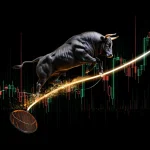
Unlocking Profits with Positive Divergence: A Trader’s Hidden Edge
Aug 27, 2024
Understanding Positive Divergence: A Key Indicator for Savvy Investors
Identifying reliable signals that can help predict future price movements is paramount in the trading world. Among the various tools and techniques available, positive divergence stands out as a potent indicator. Positive divergence occurs when the price of a stock is making lower lows while an indicator, such as the Relative Strength Index (RSI) or Moving Average Convergence Divergence (MACD), is making higher lows. This suggests that the momentum behind the price decline is weakening, hinting at a potential reversal.
The concept of divergence is deeply rooted in the principles of observation and analysis, much like the ancient Greek philosophers Anaxagoras and Empedocles, who sought to understand the world through careful study of natural phenomena. In the trading context, positive divergence signals that the market may be oversold and that a bullish reversal could be on the horizon. By recognizing this pattern, investors can position themselves to capitalize on the upcoming trend change, effectively giving them an edge in beating the market.
One of the most compelling aspects of positive divergence is its applicability across various time frames, from short-term intraday charts to long-term monthly charts. However, the signals generated on longer-term charts are more reliable and can lead to more significant price movements. This makes them particularly valuable for investors looking to make substantial gains over an extended period.
The Role of Mass Psychology in Positive Divergence
Mass psychology plays a crucial role in the formation and effectiveness of positive divergence signals. Fear often grips the market when a stock’s price is declining, leading to panic selling. This widespread selling pressure can drive prices down to levels that do not necessarily reflect the stock’s intrinsic value. However, as the sale continues, the momentum behind it may start to wane, even though the price continues to drop. This is where positive divergence comes into play.
As indicated by tools like the MACD or RSI, the weakening momentum suggests that the fear-driven selling is losing steam. At this point, the market is often saturated with pessimism, and savvy investors who can recognize the positive divergence signal may start accumulating shares in anticipation of a reversal. This behaviour aligns with the principles espoused by legendary traders like Jesse Livermore, who emphasized the importance of buying when others are selling and selling when others are buying.
His understanding of mass psychology heavily influenced Livermore’s approach to trading. He recognized that markets are often driven by the collective emotions of participants, which can lead to irrational price movements. By identifying positive divergence, investors can effectively exploit these emotional extremes to enter positions where the majority act out of fear rather than rational analysis.
Integrating Behavioral Psychology with Technical Analysis
Behavioural psychology further enriches our understanding of why positive divergence can be a powerful tool. Human beings are prone to cognitive biases, such as recency bias, which causes them to place undue weight on recent events while ignoring long-term trends. This can lead to investors continuing to sell a stock because it has been declining, even though the underlying indicators suggest that the worst may be over.
Integrating behavioural psychology with technical analysis allows investors to take a more nuanced approach to trade. For example, the MACD, a tool developed by Gerald Appel in the late 1970s, is widely used to identify positive divergence. When the MACD line crosses above the signal line after making higher lows while the stock price is making lower lows, the downtrend may be losing momentum. Investors who understand the psychological factors can recognize this as an opportunity to buy into the stock before the broader market catches on.
Michael Steinhardt, a hedge fund manager known for his contrarian approach, often relied on behavioural insights to inform his trading decisions. Steinhardt understood that markets are not always rational and that investor behaviour could create opportunities for those who are willing to go against the grain. Positive divergence, highlighting moments when the market’s emotional response is at odds with the underlying momentum, provides a clear signal for investors to act contrarily.
Real-World Examples of Positive Divergence in Action
The efficacy of positive divergence is best illustrated through real-world examples. One notable instance occurred during the financial crisis of 2008. As the stock market plummeted, several stocks diverged positively on their long-term monthly charts. Despite the ongoing decline in stock prices, indicators like the MACD and RSI began to show signs of bottoming out, signalling that the selling pressure was easing.
One such example is Ford Motor Company’s (F) performance during this period. In late 2008, Ford’s stock price made new lows as the broader market declined. However, the RSI on the monthly chart began to make higher lows, indicating a positive divergence. Savvy investors who recognized this signal and bought shares of Ford were rewarded as the stock rebounded sharply in 2009, ultimately delivering substantial gains.
Another example can be found in the technology sector during the early 2000s. After the dot-com bubble burst, many tech stocks were severely beaten down. However, by 2003, several of these stocks exhibited positive divergence on their monthly charts. Cisco Systems (CSCO) is a prime example. The stock price continued to make lower lows, but the MACD histogram formed higher lows, signalling a potential bottom. Investors who identified this divergence and entered positions in Cisco could capitalize on the subsequent recovery, as the stock saw a significant appreciation in the following years.
The Wisdom of Experts: Insights from Robertson and Beyond
Julian Robertson, founder of Tiger Management, was another legendary investor who understood the power of contrarian thinking and the importance of technical signals like positive divergence. Robertson was known for his ability to identify macroeconomic trends and position his portfolio accordingly. He often emphasized the importance of patience and waiting for the right signals before making significant investment decisions.
Positive divergence aligns with Robertson’s philosophy of waiting for the market to show its hand before acting. By identifying stocks showing positive divergence on their long-term charts, investors can position themselves to profit from the subsequent trend reversal. This approach requires discipline and the ability to tune out the market’s noise, focusing instead on the signals that truly matter.
The insights of Anaxagoras and Empedocles, who believed in the cyclical nature of the universe and the interplay of opposing forces, can also be applied to trading. The fundamental principle of market cycles is that periods of decline are often followed by periods of growth. Positive divergence is a modern embodiment of this ancient wisdom, providing a tangible signal that the forces driving a stock’s decline may weaken, setting the stage for a potential rebound.
Combining Positive Divergence with Other Strategies
While positive divergence is a powerful tool, it is most effective with other technical analysis strategies. For instance, combining positive divergence with support and resistance levels can enhance the reliability of the signal. When a stock exhibits positive divergence near a strong support level, it increases the likelihood of a reversal, as the support level acts as a psychological barrier that prevents further declines.
Volume analysis can also be a valuable complement to positive divergence. A positive divergence signal accompanied by increasing volume adds further credence to the potential reversal. Rising volume indicates that more market participants are beginning to recognize the opportunity and are starting to buy into the stock.
Jesse Livermore often emphasized the importance of timing in trading. Investors can increase their chances of entering a trade at the optimal moment by waiting for a confluence of signals, such as positive divergence, support levels, and increasing volume. This disciplined approach to trading is crucial for long-term success in the market.
The Psychological Challenge of Trading Positive Divergence
Despite its effectiveness, trading based on positive divergence is challenging. One of the primary obstacles is overcoming the natural inclination to follow the crowd. When a stock is in a downtrend, it can be not easy to go against the prevailing sentiment and buy into a position that others are fleeing. This requires a strong understanding of mass psychology and behavioral tendencies.
Investors must also be mindful of false signals. Not every positive divergence leads to a successful reversal, and it is crucial to manage risk appropriately. Setting stop-loss orders and being prepared to exit a trade if the signal fails are essential practices for protecting capital.
Michael Steinhardt’s success as a trader was mainly due to his ability to maintain a contrarian mindset while managing risk effectively. He understood that taking calculated risks, rather than following the crowd, was vital to generating outsized returns. By applying this same mindset to trading positive divergence, investors can position themselves to capitalize on market inefficiencies.
Conclusion: Harnessing Positive Divergence for Market Success
Positive divergence offers investors a powerful tool for identifying potential reversals in stock prices, mainly when these signals appear on long-term charts. By understanding the underlying principles of mass psychology, behavioral psychology, and technical analysis, investors can use positive divergence to gain an edge in the market. The insights of trading legends like Jesse Livermore, Michael Steinhardt, and Julian Robertson further underscore the value of this approach.
However, successfully trading based on positive divergence requires discipline, patience, and a willingness to go against the crowd. It is not enough to identify a positive divergence signal; investors must also be prepared to act on it, manage their risk, and maintain a long-term perspective. By doing so, they can unlock significant opportunities and achieve market-beating returns.
Positive divergence remains a timeless strategy rooted in ancient wisdom and modern technical analysis. Whether applied to individual stocks or broader market trends, this approach has the potential to help investors navigate the complexities of the market and emerge victorious.













